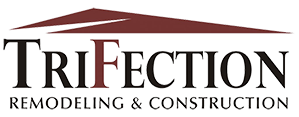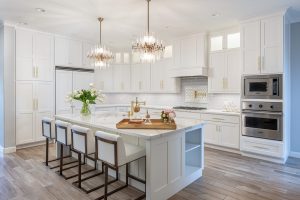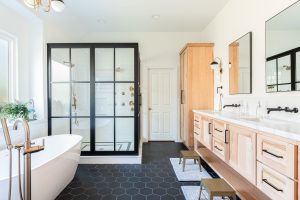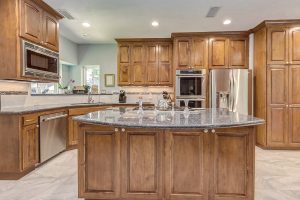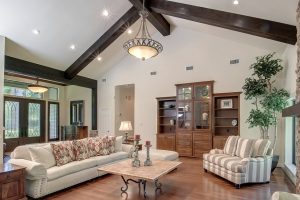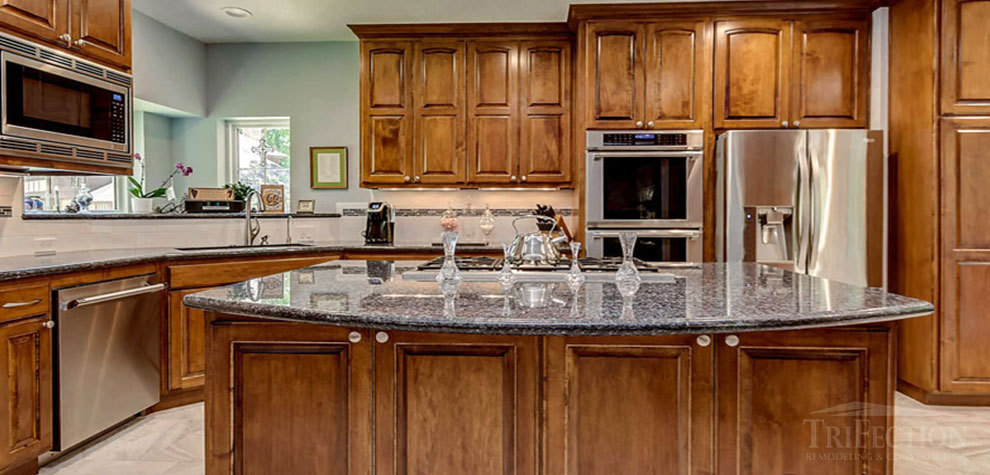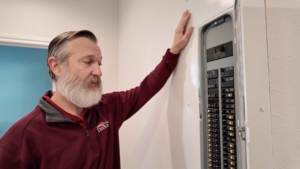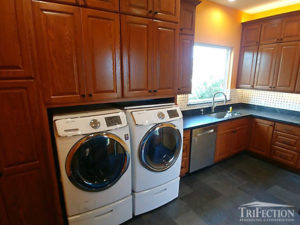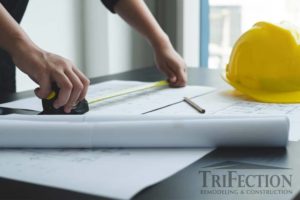Cabinets heavily influence the style of a home because they’re found in the kitchen, bathrooms, living room, etc. The selections of cabinet wood and cabinet finish define that style. Cabinet quality impacts durability and value of the home. When purchasing or remodeling a home, do not underestimate the importance of choosing the best cabinet materials to meet your objectives. Although the wood for replacing bathroom cabinets is important, the best wood for kitchen cabinets likely deserves the most attention.
While many different options for wood species exist, the most common high-quality choices include solid oak, beech, cherry, maple, and walnut. Cheaper, less durable options include pine, poplar or even fake wood substitutes like MDF and particle board. TriFection builds our custom cabinets using only premium, high-density hardwoods, which are far less susceptible to dings and dents in the future.
Our team of professionals assists our clients throughout the design and selections processes. When the remodeling process begins, we help them choose cabinets before countertops, backsplash, flooring, paint colors or fixtures. In this blog, the TriFection experts share some insights on the most common cabinetry wood species options.
How Do I Choose Cabinet Materials?
When choosing cabinetry, the first decision is whether you prefer stained or painted wood. Some homeowners prefer the natural look of wood grain while others like the consistency of a painted finish. If a TriFection client chooses paint, then we build the cabinets from solid beech wood, no matter the paint color. Beech is a high-quality hardwood. Other contractors will use cheaper, softer wood alternatives such as pine or poplar when painting cabinets.
For a stained finish, the optimal choice comes down to clients’ preferred grain pattern and budget. All of previously described hardwoods are very comparable in terms of quality and durability. However, they have distinctive grain patterns and accept stain differently, so the appeal to clients depends on individual tastes. Geography and possible tariffs typically drive price differences. Wood species sourced in the Northeast or Canada, such as cherry and maple, cost more due to the logistics involved.
Common Cabinet Materials
Here are some helpful tips regarding the most common stained cabinetry options:
Oak
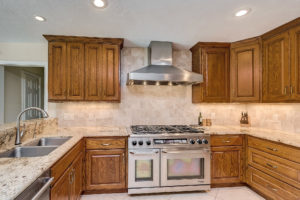 Oak has been a standard in fine furniture and cabinetry for many years. Recognized by its more prominent grain, it comes in a variety of colors, from white to pink to reddish tones. Oak accepts stain very easily, allowing cabinet makers to create a wide range of finishes that appeal to diverse tastes and complement other material selections well. While more commonly associated with a traditional look, oak can also accommodate a more contemporary style, with the right choice of cabinet hardware and countertops.
Oak has been a standard in fine furniture and cabinetry for many years. Recognized by its more prominent grain, it comes in a variety of colors, from white to pink to reddish tones. Oak accepts stain very easily, allowing cabinet makers to create a wide range of finishes that appeal to diverse tastes and complement other material selections well. While more commonly associated with a traditional look, oak can also accommodate a more contemporary style, with the right choice of cabinet hardware and countertops.
Beech
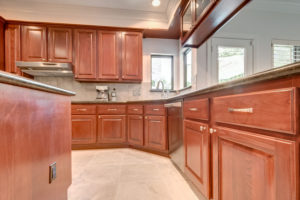 Similar to birch, beech remains a popular alternative to oak among consumers due to its more subtle grain and texture. As mentioned earlier, beech can be painted or stained. Sourced from every global hemisphere, this wood prices attractively compared to others. Master woodworkers love how it responds to tools and machinery, with very clean cuts and acceptance of stain. Beech allows you to achieve nearly any desired style for your home in a cost effective manner.
Similar to birch, beech remains a popular alternative to oak among consumers due to its more subtle grain and texture. As mentioned earlier, beech can be painted or stained. Sourced from every global hemisphere, this wood prices attractively compared to others. Master woodworkers love how it responds to tools and machinery, with very clean cuts and acceptance of stain. Beech allows you to achieve nearly any desired style for your home in a cost effective manner.
Cherry
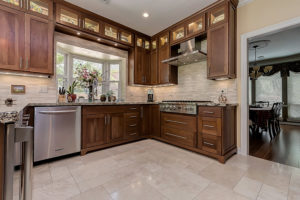 Cherry is perhaps the most highly regarded hardwood in North America. It has an extremely loyal, almost cult-like following among certain homeowners who’ve installed it previously. The grain is very smooth yet distinctive and elegant with natural variation. Early in its life, cherry starts out with a light pink or golden undertone that ultimately evolves into a very rich, bold reddish or brown hue with lustrous patina. Widely used for high-end furniture and cabinetry for many years, the best cherry trees can be found in the Northeast. Because of the logistics involved and its popularity among traditional and contemporary consumers, expect to pay more for cherry cabinets.
Cherry is perhaps the most highly regarded hardwood in North America. It has an extremely loyal, almost cult-like following among certain homeowners who’ve installed it previously. The grain is very smooth yet distinctive and elegant with natural variation. Early in its life, cherry starts out with a light pink or golden undertone that ultimately evolves into a very rich, bold reddish or brown hue with lustrous patina. Widely used for high-end furniture and cabinetry for many years, the best cherry trees can be found in the Northeast. Because of the logistics involved and its popularity among traditional and contemporary consumers, expect to pay more for cherry cabinets.
Maple
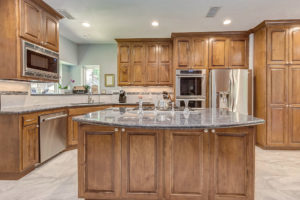 Maple is an incredibly strong, durable, and attractive wood species. Known for its smooth but tight grain, maple does not accept stain easily. Consequently, the finished product will appear “blotchy” and uneven in some areas, which is part of the natural character. If that inconsistent look does not appeal to you, definitely pick a different wood. Cabinet finishers must spend more time working with maple to achieve a desired look, which adds to the expense along with the sourcing from the Northeast and Canada. Originally with a light creamy color, maple naturally patinas to darker shades over time. You can create many unique looks with maple, including distressed. True wood aficionados love maple.
Maple is an incredibly strong, durable, and attractive wood species. Known for its smooth but tight grain, maple does not accept stain easily. Consequently, the finished product will appear “blotchy” and uneven in some areas, which is part of the natural character. If that inconsistent look does not appeal to you, definitely pick a different wood. Cabinet finishers must spend more time working with maple to achieve a desired look, which adds to the expense along with the sourcing from the Northeast and Canada. Originally with a light creamy color, maple naturally patinas to darker shades over time. You can create many unique looks with maple, including distressed. True wood aficionados love maple.
Walnut
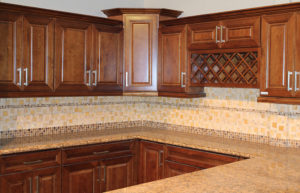 Walnut is known for its brown hues, ranging from dark browns to redder, lighter browns. Light yellow or light brown sapwood may also be present. As it ages, the colors may lighten or mellow. Walnut features calming wood grains with parallel grain lines of varying thickness. Its warm, rich colors also accept stain finishes well. Like maple, walnut offers a high degree of natural variation in grain and colors that attracts wood lovers. While its grown throughout United States and southern Canada, most commercial quantities are sourced from the Northeast.
Walnut is known for its brown hues, ranging from dark browns to redder, lighter browns. Light yellow or light brown sapwood may also be present. As it ages, the colors may lighten or mellow. Walnut features calming wood grains with parallel grain lines of varying thickness. Its warm, rich colors also accept stain finishes well. Like maple, walnut offers a high degree of natural variation in grain and colors that attracts wood lovers. While its grown throughout United States and southern Canada, most commercial quantities are sourced from the Northeast.
Call TriFection Today!
The woodworking experts at TriFection will gladly help you make the right cabinetry decisions for your home. We can build stunning custom cabinets from not only the hardwoods described above but also birch, hickory, alder, pecan, and others.
For more information about kitchen cabinet materials or any custom cabinetry, call TriFection at 281-KITCHEN. You can also send us a message on our website to start the consultation process.
